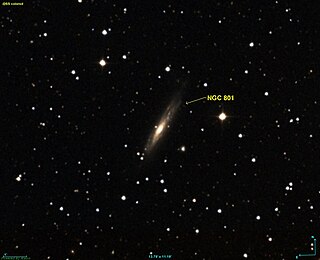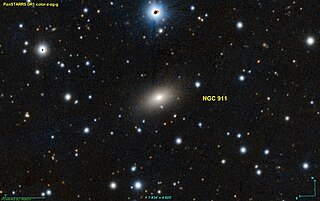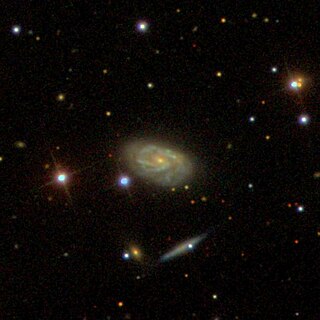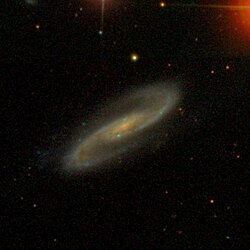
NGC 2998 is a barred spiral galaxy located in the constellation Ursa Major. It is 195 million light-years away from the Earth. It is an intermediate spiral galaxy. Its stellar mass is about that of the Milky Way.

NGC 972 is a dusty spiral galaxy in the northern constellation of Aries, located at an approximate distance of 49.8 Mly from the Milky Way. It was discovered in 1784 by William Herschel. The galactic features suggest it may have undergone a merger with a gas-rich companion, giving it asymmetrical arms, plus starburst activity in the nucleus and an off-planar nuclear ring. The inner 3.6 kpc of the galaxy is undergoing star formation at the rate of 2.1–2.7 M☉·yr−1, but it lacks a nuclear bulge.

NGC 834 is a spiral galaxy located in the Andromeda constellation. It is estimated to be 160 million light-years away from the Milky Way galaxy and has a diameter of about 65,000 light-years. The object was discovered on September 21, 1786 by the astronomer William Herschel.

NGC 801 is a spiral galaxy with an active galaxy core in the constellation Andromeda. It is estimated to be 174 million light-years from the Milky Way and has a diameter of approximately 174,400 light-years. The object was discovered on September 20, 1885 by the American astronomer Lewis A. Swift.

NGC 701 is a spiral galaxy with a high star formation rate in the constellation Cetus. It is estimated to be 86 million light years from the Milky Way and has a diameter of approximately 65,000 light years. The object was discovered on January 10, 1785 by the German-British astronomer William Herschel.

NGC 960 is a spiral galaxy in the constellation Cetus. The galaxy was discovered in 1886 by Francis Preserved Leavenworth.

NGC 850 is a lenticular galaxy in the constellation Cetus. It is estimated to be 300 million light-years from the Milky Way and has a diameter of approximately 130,000 ly.

NGC 910 is an elliptical galaxy in the constellation of Andromeda. NGC 910 was discovered on October 17, 1786 by the German-British astronomer William Herschel. It is the brightest galaxy in the cluster Abell 347.

NGC 812 is a spiral galaxy located in the Andromeda constellation, an estimated 175 million light-years from the Milky Way. NGC 812 was discovered on December 11, 1876 by astronomer Édouard Stephan.

NGC 911 is an elliptical galaxy located in the constellation Andromeda about 258 million light years from the Milky Way. It was discovered by French astronomer Édouard Stephan in 1878. It is a member of the galaxy cluster Abell 347.

NGC 941 is an intermediate spiral galaxy in the constellation Triangulum. It is an estimated 55 million light-years from the Milky Way and has a diameter of approximately 55,000 light years. The galaxies NGC 926, NGC 934, NGC 936, NGC 955 are located in the same sky area. NGC 941 was discovered by the astronomer William Herschel using on 6 January 1785.

NGC 821 is an elliptical galaxy in the constellation Aries. It is estimated to be about 80 million light-years from the Milky Way and has a diameter of approximately 55,000 light years. NGC 821 was discovered on September 4, 1786, by astronomer Wilhelm Herschel.

NGC 766 is an elliptical galaxy located in the Pisces constellation about 362 million light years from the Milky Way. It was discovered by British astronomer John Herschel in 1828.

NGC 768 is a barred spiral galaxy located in the constellation Cetus about 314 million light years from the Milky Way. It was discovered by the American astronomer Lewis Swift in 1885.

NGC 769 is a spiral galaxy located in the constellation Triangulum about 197 million light years from the Milky Way. It was discovered by the American astronomer Truman Safford in 1866.

NGC 644 is a barred spiral galaxy in the constellation Phoenix in the southern sky. It is estimated to be 270 million light-years from the Milky Way and has a diameter of approximately 130,000 light-years. Together with NGC 641, it probably forms a gravitationally bound pair of galaxies. The object was discovered on September 5, 1834 by John Herschel.

NGC 532 is a spiral galaxy in the constellation Pisces. The galaxy is approximately 100 million light-years away from the Earth, and was discovered on September 21st 1786 by the German-British astronomer William Herschel.

NGC 624 is a barred spiral galaxy in the constellation of Cetus, which is about 264 million light years from the Milky Way. It was discovered on November 28, 1785, by the German-British astronomer William Herschel.

NGC 636 is an elliptical galaxy in the Cetus constellation. It is located about 96 million light-years from the Milky Way. It was discovered by the German–British astronomer William Herschel in 1785.

NGC 3902 is an intermediate spiral galaxy in the constellation Leo. It was discovered on April 6, 1785, by William Herschel and observed on February 19, 1827, by John Herschel. It is estimated to be 180 to 185 million light-years away, and its redshift-independent distance estimates to about 185 to 240 million light-years. It is around 75,000 light-years in diameter.





















